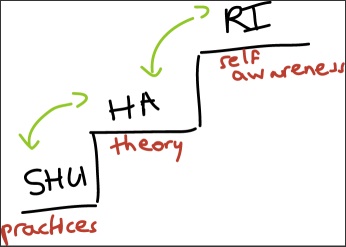 Malu’s One Rule – Malu Sciamarelli
Malu’s One Rule – Malu Sciamarelli
I was reading a magazine last week, and an ad caught my eye: To break the rules, you must first master them. It got me thinking how true that was, but being busy, I simply forgot that as I moved into reading something related to work. Coincidentally, the following day when I was asked about rules in the classroom, that line came back to me and a myriad of new questions buzzed in my mind: Do I follow rules in my classroom or do I break them? Do I really need to master rules to break them? Lots of questions — but still no answers.
Then, curious about that ad and wanting to know about its underlying principles, I searched on the Internet and I found out it’s a way of thinking about how you learn a technique. It comes from Aikido. Alistair Cockburn
< http://alistair.cockburn.us/Shu+Ha+Ri

introduced it as a way of thinking about learning techniques and methodologies for software development. The main idea is that a person passes through three stages of gaining knowledge: Shu-Ha-Ri. I reflected this could be extended to stages in teaching development. So, how do I see this concept in my classroom?
Shu: In this beginning stage you follow the teachings of one master precisely. You remain faithful to rules without deviation. You learn how to make groups in a communicative classroom, for example, and stick to the method you were taught.
Ha: At this point you begin to branch out. You can make innovations, which means rules can be broken and/or discarded. As an example, you use different ways to correct students, mainly adaptations as your confidence grows.
Ri: Now you aren’t learning from other people, but from your own practice. You create your own approaches and adapt what you’ve learned to your own particular circumstances. In this phase, there are no rules, only creativity leading to where you act in accordance with what you judge to be the best.

Here you create completely new ways to practice a negotiation skill that you came up with yourself, not following a tried or tested formula, for instance.
I do believe that in order to get to this point, we need to learn skills and practices that develop us first. Only then can we break rules and explore.
I remember two cases in which I followed different routes. In the first, a group of teenagers had an oral test, and as it was a beautiful day they didn’t want to stay inside, but begged for the school garden. We are allowed to do some activities outside, but not tests. I decided to follow the school rules, making sure they all knew about my decision and all the reasons. They complained a lot at first, but at the end of the test, they all agreed it was one the best things we ever did. They were not only assessed, but also learned a lot from each other and we all had a great time together. That test developed into projects for several other classes – this time in the school garden.
In the second case, I was replacing a teacher and I had to follow her lesson plan. They had a very long listening that would take almost the whole class and leave no time for other activities. I then decided to change her whole lesson plan, shortening the listening and doing activities in which the students would benefit more. I deliberately broke the school rules. When I told the teacher what I had done and showed her the results, it led to a good peer collaboration.
In both cases all I had in mind was to do what I judged would benefit students best at that given moment. And the results showed I made the right decision. Following the rules in the first example didn’t make me feel restrictive and limiting, just as breaking the rules in the second one didn’t make me feel powerful or freer. In both cases, I just felt I made the right decision.
So, what rules do I follow in my classroom?
Only one: choosing what is the best for my students.

Hi,Malu
I loved your idea of using the Shu-Ra-Hi principle in teaching development. However, I’d like to learn more about how to best use it in my classroom. Why don’t you write something more about it? 🙂
Cheers,
Katia
Thanks for you comment, Katia. Actually, I am already writing about it. You’ll see it soon! 😉
Malu, congratz!!!!!!!! It was awesome!!!! I see you as an inspiration!!! XOXO, Becky
Thank you so much, Beccy! Your happiness and always positive attitude is an inspiration for me too!
Malu, as always, thought provoking. Loved the Shu Ha Ri connection. Can´t wait to read more about it!
Thank you, Malica. I’ll write more about it very soon! 🙂
Malu, I’d apolozige for not having read it before, but I won’t: I’m sure I was the one who missed the most! Congrats 🙂
Thank you for reading, Dani!